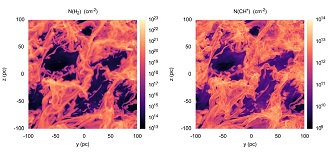3D chemical structure of the diffuse turbulent interstellar medium. II. The origin of CH+: A new solution to an 80-year mystery
- Details
- Published on 13 January 2023
Vol. 669
6. Interstellar and circumstellar matter
3D chemical structure of the diffuse turbulent interstellar medium. II. The origin of CH+: A new solution to an 80-year mystery

Since its first detection in 1941, the widespread presence of CH+ in the interstellar medium has posed a chemical conundrum. This cation is easily destroyed by collisions and photo-dissociation, but its only efficient formation mechanism consists of a highly endothermic reaction that requires both high gas temperature and the presence of molecular hydrogen, which is mainly formed in cold environments. To investigate the formation of CH+ in turbulent and multiphase environments, Godard and collaborators have carried out magnetohydrodynamic simulations of the diffuse interstellar medium, following the time-dependent abundance of the different forms of hydrogen and combining the results with a post-processing treatment of the CH+ chemistry. As a result of their simulations, the authors show that the quasi-totality of the CH+ mass originates from unstable gas, and that the formation process is driven by warm and out-of-equilibrium H2 initially formed in the cold neutral medium and injected into more diffuse environments through a combination of advection and thermal instability. These new simulations naturally reproduce the observed abundances of CH+ and additional related observables, offering a natural solution to an 80-year-old chemical conundrum.

